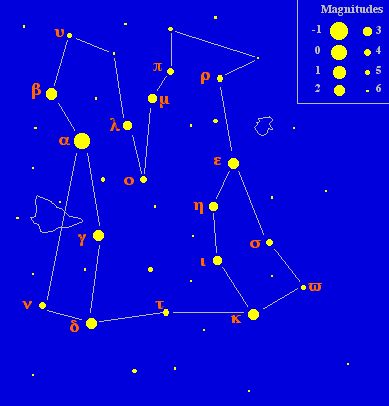A prominent constellation in the skies of Amny.
from My First Album of Stars & Planets: Amny Edition, Markgraf Publishing, Credix, Year MDCCCLXI of the Imperium, in the Reign of the August Imperator Nina II.
Aurick's Tower

General:
Abbreviation: AMNY-Aur
Genitive: Aurickae Toweris
Aurick's Tower is one of the most spectacular constellations in Amny's sky. It is said to represent the twin-capped tower built by the architect Aurick in order to shelter the two Golden Eggs of the Dragon Kleipnir.
Stars:
Alpha, the second-brightest star in Amny's sky, is an A-type star, magnitude -1.32, at a distance of 2.48 parsecs. Alpha has a magnitude 7.4 companion at a separation of 7 seconds of arc.
Beta is a B2 star with magnitude 1.6, distance 110 parsecs.
Gamma is the G-type star also known as Rho Callena, the primary of the planet Credix.
Delta is a B-type star with magnitude 2.1, at a distance of 20.9 parsecs.
Epsilon is a binary star. The bright component is of spectral type O9, magnitude 2.2; the companion is an M3 red dwarf of magnitude 6.3. Both stars are at a distance of 430 parsecs.
Iota is a G2 star with no habitable planets; the Imperium maintains a military training and refueling base in the system. Iota is of magnitude 2.8 and distance 96.6 parsecs.
Kappa is a B9 star with magnitude 3.3, distance 65.9 parsecs.
Lambda is an A5 star with magnitude 3.4, lying 28.1 parsecs from Amny.
Mu is a G8 star, magnitude 3.6, distance 22.1 parsecs. It has one habitable planet, Rettung.
Nu is a B8 star, magnitude 4.1, distance 305.7 parsecs
Omicron is an F6 of magnitude 4.2, distance 8.6 parsecs.
Pi is a binary. One star is an F2, of magnitude 4.5; the other is an F0 of magnitude 4.3. The pair lies 43 parsecs from Amny.
Rho is a K0 star of magnitude 4.6, distance 63.2 parsecs.
Sigma is an F5 star at a distance of 26 parsecs. Its magnitude is 4.9.
Tau is a member of the rare class of carbon stars, very cool and very red in appearance. It varies brightness from magnitude 5.5 to 10.5 over a period of approximately 624 days. At its brightest, Tau is a coppery red; at its faintest, it is described as a deep blood red. Definitely worth observing with a small telescope.
Omega is a K6 star with magnitude 5.5, distance 139.5 parsecs.
Star Clusters:
There are two open clusters and three globular clusters in Aurick's Tower. The open clusters are all small and faint, between 10th and 11th magnitude. They can be found by scanning the constellation with a small telescope. IGSGC 32463 is an 8th magnitude globular cluster, about 12 minutes across, located near Kappa Aurickae Toweris. IGSGC 12597 is a 7th magnitude globular cluster about 5 minutes in diameter, between Delta Aurickae Toweris and Nu Aurickae Toweris. IGSGC 99823 is a 10th magnitude globular cluster located on the Tower's eastern border, near Galgen.
Nebulae:
IGSN 234769 is of about 10th magnitude; its central star is also of 10th magnitude. It is located northeast of Epsilon Aurickae Toweris. IGSN 523876 is a diffuse nebulosity of about 5th magnitude west of Gamma Aurickae Toweris.
Galaxies:
Several galaxies lie within Aurick's Tower, but all are of magnitude 12 or fainter.